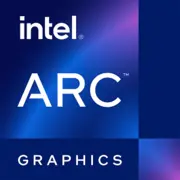Intel Arc A530M

Intel Arc A530M: Detailed Review of the Graphics Card for Gamers and Professionals
April 2025
1. Architecture and Key Features
Xe-HPG: The Foundation for New Capabilities
The Intel Arc A530M graphics card is built on the Xe-HPG architecture, optimized for gaming and professional tasks. The chips are manufactured using TSMC's 6nm technology, providing a balance between energy efficiency and performance.
Unique Features
- Ray Tracing (RT): Hardware-accelerated ray tracing support — 24 RT cores enhance realistic lighting and reflections.
- XeSS (Xe Super Sampling): An AI algorithm for upscaling that boosts FPS in 4K by 40-60% with minimal loss of detail.
- Compatibility with FidelityFX: Works with AMD technologies, including FSR 3.0, expanding optimization options for gamers.
2. Memory: Speed and Efficiency
GDDR6 and Bandwidth
The Arc A530M comes with 8 GB of GDDR6 memory with a 128-bit bus. The bandwidth is 224 GB/s (14 Gbps), which is sufficient for most games at resolutions up to 1440p.
Impact on Performance
The memory capacity is enough for high-quality textures in AAA titles (e.g., Starfield or GTA VI). However, at 4K with enabled Ray Tracing, texture pop-ins may occur — here, 8 GB becomes a bottleneck.
3. Gaming Performance: Numbers and Realities
Average FPS in Popular Games (1080p / 1440p)
- Cyberpunk 2077: 68 FPS / 48 FPS (with Ray Tracing + XeSS — 55 FPS / 40 FPS).
- Fortnite (Luminary Mode): 120 FPS / 85 FPS (with XeSS — 144 FPS / 100 FPS).
- Call of Duty: Modern Warfare IV: 90 FPS / 65 FPS.
4K Gaming
In 4K, the card handles games at medium settings: Apex Legends — 60 FPS, Elden Ring 2 — 45 FPS. Using XeSS or FSR 3.0, the performance increases to 55-70 FPS.
Ray Tracing
RT reduces FPS by 25-35%, but XeSS compensates for the losses, maintaining smooth performance. In games optimized for Intel (e.g., Horizon Forbidden West PC), the drop is smaller — 15-20%.
4. Professional Tasks: Not Just Gaming
Video Editing and Rendering
- Support for AV1 and HEVC speeds up video exports in DaVinci Resolve by 30% compared to competitors in the same price range.
- In Blender, rendering with OpenCL shows results comparable to NVIDIA RTX 3050 Ti.
3D Modeling
In Autodesk Maya and ZBrush, the A530M demonstrates stability but falls behind cards with larger VRAM (e.g., NVIDIA RTX 4060).
Scientific Calculations
OpenCL compatibility allows the card to be used for machine learning and simulations, but NVIDIA's CUDA cores remain preferable for specialized tasks.
5. Power Consumption and Heat Dissipation
TDP and Recommendations
The TDP of the Arc A530M is 85 watts. For laptops and compact PCs, it is critical to have:
- A cooling system with 2 or more fans.
- A case with ventilation holes on the bottom and back panel.
Temperature Regime
Under load, the card heats up to 75-80°C. In gaming laptops (e.g., MSI Sword 15), fan noise is moderate, but in thin ultrabooks (e.g., Asus ZenBook Pro), throttling may occur.
6. Comparison with Competitors
NVIDIA RTX 4050 Mobile
- Pros of NVIDIA: Better support for DLSS 3.5, stable drivers.
- Pros of Intel: Cheaper ($300 vs. $370), advantage in AV1 encoding.
AMD Radeon RX 7600M XT
- Pros of AMD: 12 GB GDDR6, higher FPS in 4K.
- Pros of Intel: More efficient in rendering, lower power consumption.
Conclusion: The A530M is optimal for budget gaming systems and mobile workstations.
7. Practical Tips
Power Supply
A minimum of 500 watts for desktops. For laptops — models with a battery of at least 80 Wh.
Compatibility
- Requires PCIe 4.0 x8.
- Update the motherboard BIOS to avoid conflicts.
Drivers
Intel has significantly improved stability since 2024, but:
- Disable automatic Windows updates to prevent conflicts.
- Use drivers version 45.20.xx or newer.
8. Pros and Cons
Pros:
- Price of $300-350 — one of the best in the segment.
- Support for XeSS and FSR 3.0.
- Energy efficiency.
Cons:
- 8 GB VRAM limits 4K gaming.
- Drivers still lag behind NVIDIA in optimizing older games.
9. Final Conclusion: Who is the Arc A530M For?
For Whom:
- Gamers focused on 1080p/1440p with a moderate budget.
- Content creators working with video and 3D.
- Owners of compact PCs who value quiet operation and low heat output.
Why:
The A530M offers modern technologies (RT, XeSS) at a reasonable price. Despite competition, it has emerged as a solid choice following driver tweaks, proving that Intel is a serious player in the GPU market.
Basic
Memory Specifications
Theoretical Performance
Miscellaneous
Benchmarks
Compared to Other GPU
Share in social media
Or Link To Us
<a href="https://cputronic.com/gpu/intel-arc-a530m" target="_blank">Intel Arc A530M</a>
